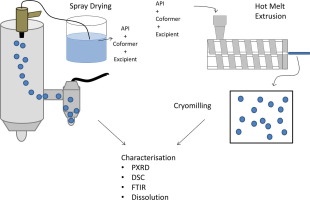Engineering of pharmaceutical cocrystals in an excipient matrix: spray drying versus hot melt extrusion

The comparison of spray drying versus hot melt extrusion (HME) in order to formulate amorphous solid dispersions has been widely studied. However, to the best of our knowledge, the use of both techniques to form cocrystals within a carrier excipient has not previously been compared. The combination of ibuprofen (IBU) and isonicotinamide (INA) in a 1:1 molar ratio was used as a model cocrystal. A range of pharmaceutical excipients was selected for processing – mannitol, xylitol, Soluplus and PVP K15. The ratio of cocrystal components to excipient was altered to assess the ratios at which cocrystal formation occurs during spray drying and HME. Hansen Solubility Parameter (HSP) and the difference in HSP between the cocrystal and excipient (ΔHSP) was employed as a tool to predict cocrystal formation. During spray drying, when the difference in HSP between the cocrystal and the excipient was large, as in the case of mannitol (ΔHSP of 18.3 MPa0.5), a large amount of excipient (up to 50%) could be incorporated without altering the integrity of the cocrystal, whereas for Soluplus and PVP K15, where the ΔHSP was 2.1 and 1.6 MPa0.5 respectively, the IBU:INA cocrystal alone was only formed at a very low weight ratio of excipient, i.e. cocrystal:excipient 90:10. Remarkably different results were obtained in HME. In the case of Soluplus and PVP K15, a mixture of cocrystal with single components (IBU and INA) was obtained even when only 10% excipient was included. In conclusion, in order to reduce the number of unit operations required to produce a final pharmaceutical product, spray drying showed higher feasibility over HME to produce cocrystals within a carrier excipient.

